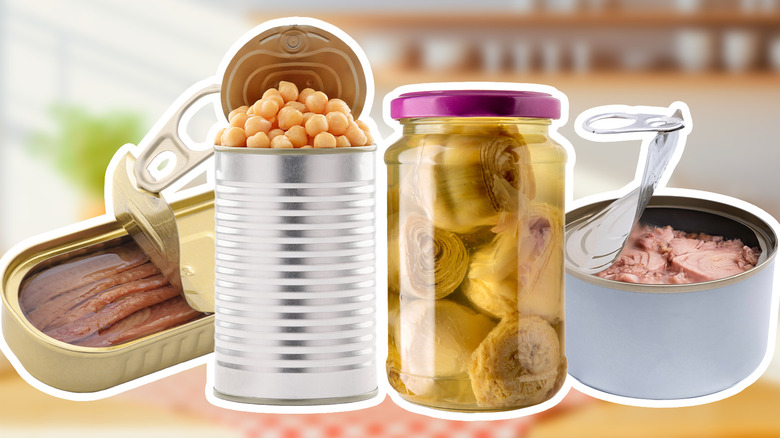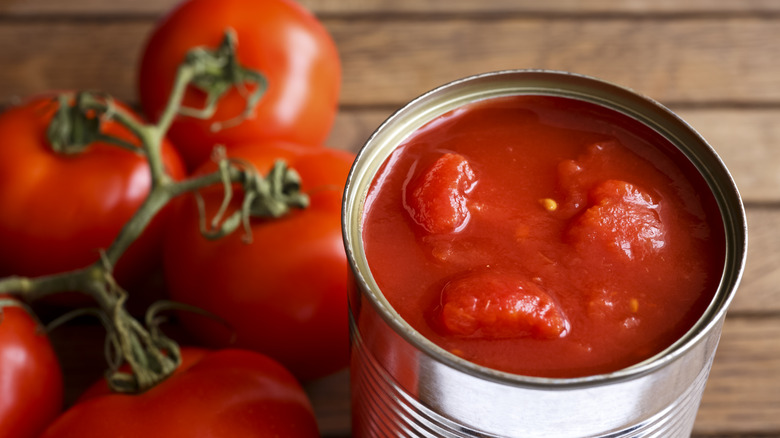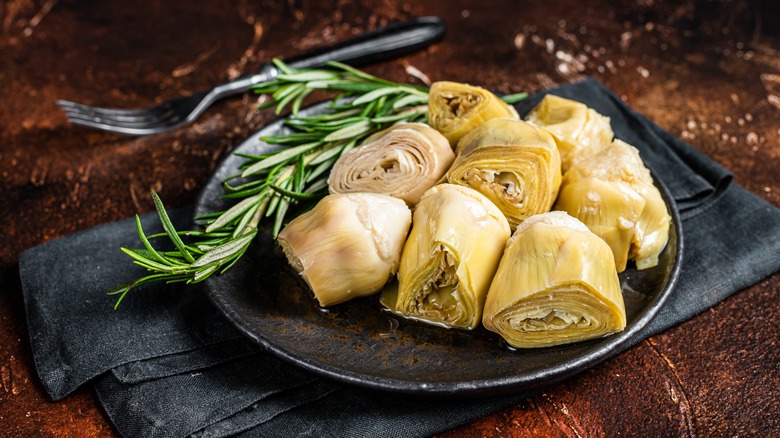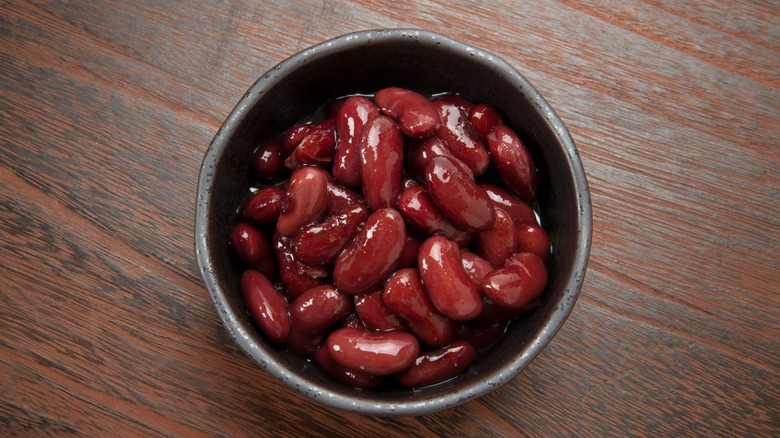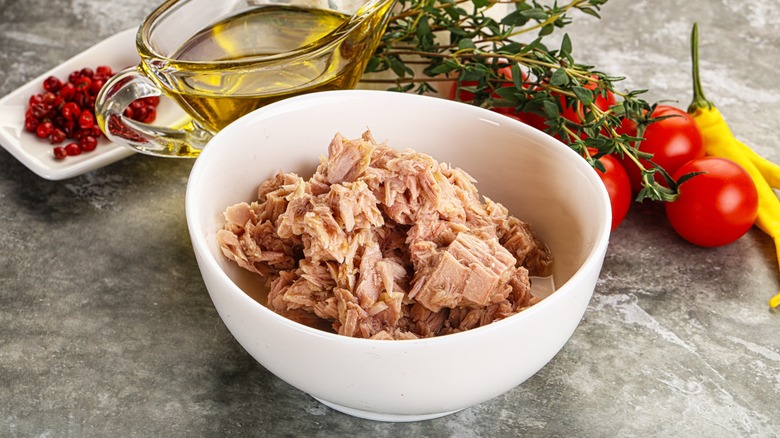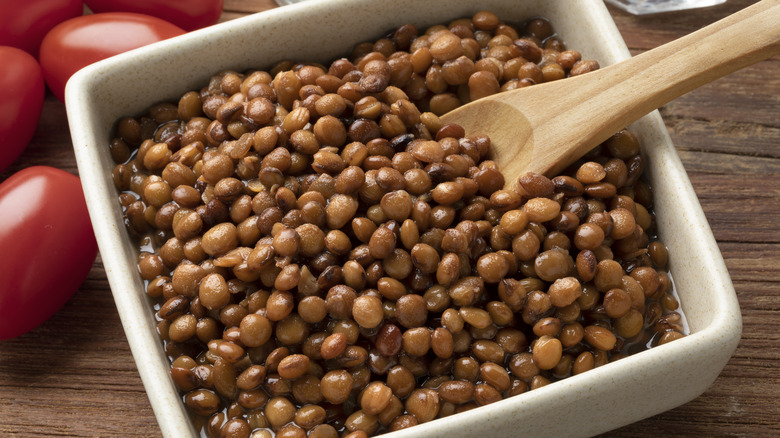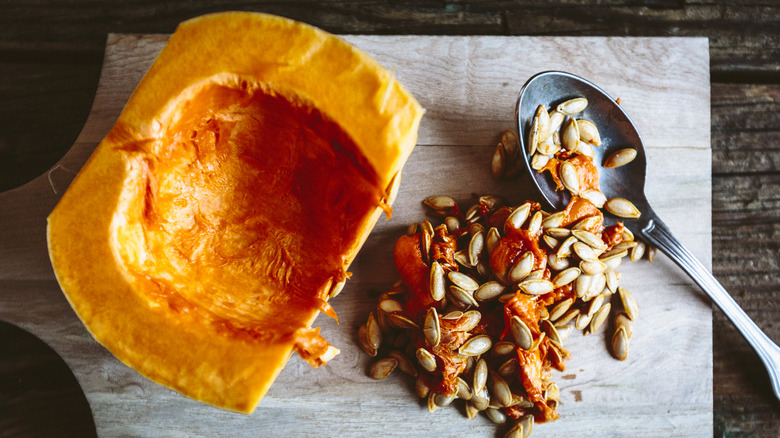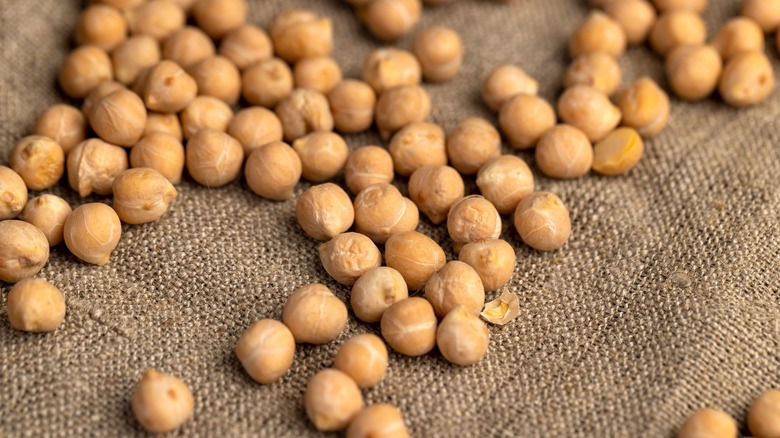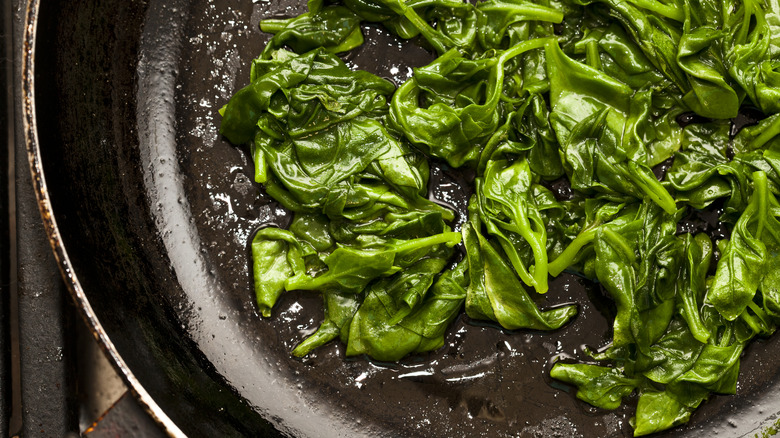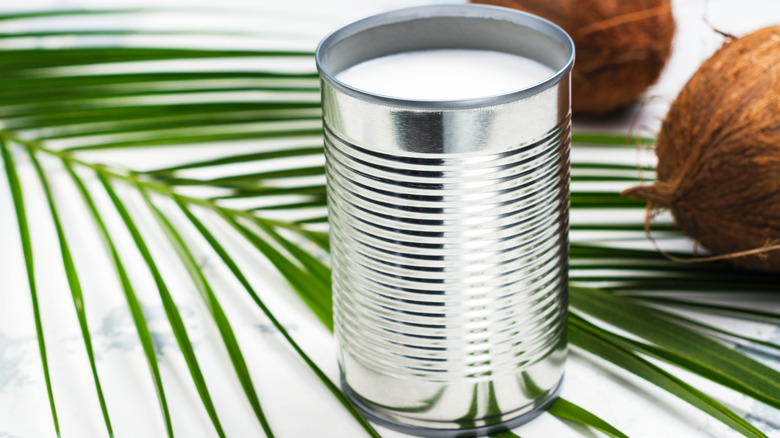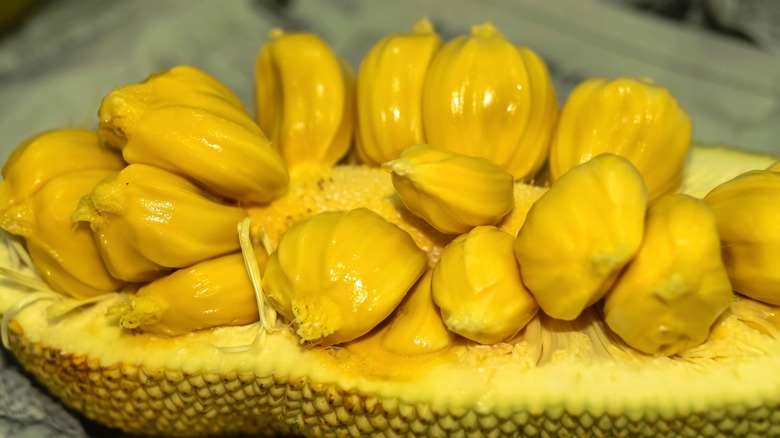11 Canned Foods That Are Just As Good As Fresh, According To Chefs
Canned foods often get a bad rap, with many believing they're unhealthy or inferior to fresh options. However, this is more myth than fact, and both chefs and science can back this up. Health chef and "Chopped" champion Julia Chebotar explains, "While fresh foods are generally higher in certain nutrients, many canned foods retain comparable nutritional value due to being processed at peak ripeness." Canned foods are also processed from high-quality raw ingredients and must meet stringent safety requirements, ensuring that they are not only nutritious but also safe to consume.
Beyond nutrition, when it comes to flavor and texture, many canned foods can easily rival their fresh counterparts. In fact, sometimes choosing canned is the better option because the canning process can enhance the texture of certain items, making them ideal for specific dishes. For instance, canned tomatoes offer just the right consistency for a rich, homemade sauce. Chef Theo Michaels, author of "Canned: Quick and Easy Recipes That Get the Most Out of Tinned Food," suggests we "stop thinking of canned ingredients as a fresh alternative but view (most of) them as ingredients in their own right." This shift in perspective highlights the unique qualities of canned foods, encouraging us to appreciate them as more than just a substitute. With all of this in mind, let's explore chef-approved canned foods that are just as good as fresh.
Canned tomatoes
Canned tomatoes are a kitchen staple, transforming ordinary dishes into rich, flavorful meals with minimal effort. While they're not great for recipes that require fresh tomatoes, namely salads, their soft texture makes them especially useful in slow-cooked dishes. Chef Theo Michaels notes about canned tomatoes, "they help add depth to a variety of sauces, stews, curries, and dishes that need a little juice." Unlike fresh tomatoes, which can vary greatly depending on the time of year, canned tomatoes are a reliable choice you can always count on.
Beyond their texture, canned tomatoes save you lots of time and effort. They require little to no peeling or chopping, which makes them perfect for quick weeknight dinners or when you're cooking for a crowd. And their long shelf life means they're a pantry must-have that's always ready to go. For an extra layer of flavor, roasting canned tomatoes "can caramelize their natural sugars, adding depth and complexity to their flavor," according to Julia Chebotar. Between their convenience and consistent quality, canned tomatoes are a versatile ingredient that makes cooking both easier and sometimes tastier.
Canned artichokes
Canned artichokes are a lifesaver when you're cooking, especially considering that fresh artichokes can be a real hassle. Each fresh artichoke demands lots of time and effort for a small yield of edible parts, involving peeling, trimming, and handling thorny leaves. "Canned artichokes are tender and ready to use, saving time and effort," says Julia Chebotar. For Chebotar, canned artichokes' convenience and flavor shine especially bright in quick recipes like dips and salads, eliminating the tedious prep work and letting you enjoy the artichoke's deliciousness without so much fuss.
To get the most out of canned artichokes, it's important to remember that, when incorporating them into your dishes, they are usually pretty soft. "Be conscious of adding them at the end of cooking so they don't dissolve into the dish," says Theo Michaels. This way, you can enjoy their tenderness without them turning mushy. Also when choosing canned artichokes at the grocery store, go for those packed in water instead of oil if you want to cut down on added fat. But here's the thing — whether they're packed in water or oil, they almost always come with quite a bit of added salt. To keep both the fat and sodium in check, simply give them a good rinse before using them. It's a quick and easy trick that can help make your artichoke-infused recipes lighter and healthier.
Canned beans
Whether you're cooking up a hearty black bean soup, a zesty pinto bean salad, or simply adding them to your quesadilla, canned beans are a great item to have around at all times. As Julia Chebotar puts it, "Canned beans ensure a quick and easy preparation while maintaining nutritional value." Canned beans are packed with fiber, protein, and essential nutrients like iron and zinc. They're great for promoting digestive health, supporting a healthy gut, and maintaining healthy blood pressure.
One of the best things about canned beans is how much time you save. They're pre-cooked and ready to go, which cuts down immensely on prep time and effort. For comparison, soaking and cooking dried beans from scratch can take several hours. Typically, you'll need to soak them for six to eight hours and then cook them for another hour or two. To get the most out of canned beans, a quick rinse can be a game changer, according to Chebotar. Rinsing not only helps reduce sodium content but also washes away any metallic taste from the canning liquid. This simple step can help achieve a fresher flavor and make your dishes even more enjoyable. And for an extra flavor kick, she also highly recommends sautéing them in garlic and olive oil.
Canned tuna
Let's be real: Canned tuna is in a league of its own. It doesn't replace fresh tuna by any means, but it offers something totally different. For example, you wouldn't use it for a delicate sushi roll or a fresh ceviche, but for an easy and satisfying tuna salad or a hearty pasta dish, it's unbeatable. Generally speaking, you'd rarely choose fresh tuna for those dishes anyway.
Speaking of fresh tuna, its cost can be prohibitively expensive when you're just trying to whip up a meal. Canned tuna, on the other hand, is a great budget-friendly option that will give you nearly all the same nutrients: high-quality protein, omega-3 fatty acids, and essential vitamins and minerals. As such a satisfying, healthy alternative why break the bank on fresh tuna for everyday dishes? Plus, its convenience can't be beat. When you need a quick, nutritious boost, canned tuna is always there for you with just a quick twist of the can opener. For an even healthier choice, Julia Cheborar recommends choosing canned tuna that's packed in water rather than oil to cut down on calories and fat.
Canned lentils
Canned lentils are fantastic for a number of reasons, especially when compared to their fresh counterparts. First of all, their delicious, earthy flavor and satisfying texture are no different from fresh, dried lentils. On top of that, you won't miss out on any of their heart-healthy fiber, plant-based protein, or essential vitamins and minerals either. The only major difference is that canned lentils have a lot of added sodium, but giving them a good rinse before including them in your recipes can wash some of it off.
Chef Theo Michaels puts it perfectly when he says canned lentils "are brilliant for sheer convenience; no need to soak overnight, making them great for an impromptu addition to any meal." He also points out that "they are super cost-effective," and since they have such a long shelf-life, choosing canned over dried lentils "also helps cut down on your food waste." This means less time prepping and more time enjoying your meals, all while being easy on your wallet and the planet.
Canned pumpkin
Fresh pumpkins are great in theory, but prepping them? That's a whole different story. You have to wrestle with the tough outer skin, scoop out the seeds and stringy insides, and then cook it down to just the right consistency. Even after all that effort, fresh pumpkin can still be hit or miss — sometimes it turns out stringy, watery, or just doesn't have the right texture for your recipe. Canned pumpkin is way easier to manage. All you have to do is get the can open, and voilà, you're ready to start cooking. Chef Julia Chebotar points out that canned pumpkin offers a smooth, consistent texture every time, which makes it perfect for everything from baking pies and muffins to whipping up soups and savory dishes.
Nutritionally, canned pumpkin is a great source of vitamin A, beta carotene, and fiber, so you're not sacrificing any goodness by going the easy, convenient route. That being said, you'd be wise to check the label for added ingredients before buying it, as many options for canned pumpkin are far from pure. Some brands include sugar or spices, which might be fine for certain recipes but not ideal if you're after that true pumpkin flavor. Opt for pure, unsweetened pumpkin purée to keep things healthiest. You can always add your own sweetener and spices later.
Canned chickpeas
Canned chickpeas, also known as garbanzos, will easily save you from hours of work compared to the fresh, dried version. Between soaking them overnight and then boiling them for hours, you're talking about a lot of premeditation to even use them. Meanwhile, with canned chickpeas, you pop open the can, rinse them off to remove any excess sodium or lingering metallic taste, and you're ready to begin cooking in minutes. Julia Chebotar agrees: "Canned chickpeas are the best way to make a quick, healthy, nutritious hummus." Even if hummus isn't your thing, canned chickpeas work for plenty of dishes, including hearty salads, soups, and curries.
Just like when you get them fresh, canned chickpeas are rich in fiber, protein, and essential vitamins and minerals. Plus, they maintain the same nutty flavor and grainy texture no matter if you use fresh or canned. And when it comes to cost, canned chickpeas are only slightly more expensive than dried ones. Given the significant time and effort they save, it's well worth it. All and all, canned chickpeas offer the same flavor, texture, and quality as fresh ones, so keeping a few cans in your pantry for convenience is a no-brainer.
Canned spinach
While fresh spinach is great for salads or light stir-fries — where you want that crisp leafy texture — canned spinach shines in lots of slow-cooked dishes. As Theo Michaels notes, "Canned spinach for certain curries is brilliant." He also emphasizes that "for cost and convenience, you would have to buy kilos of spinach to wilt down to the same quantity as canned." So, although fresh spinach isn't typically a budget-buster, canned spinach is still the more economical choice. With those extra savings, you could splurge on a high-quality olive oil to further elevate your home-cooked meals.
In terms of nutritional quality, canned spinach holds its own, offering a solid dose of essential vitamins and minerals, such as vitamins A, C, and K1, as well as iron and calcium. Chef Michaels mentions that the spinach used for canning comes from "older, more fibrous leaves as opposed to baby leaves," which are higher in fiber and other nutrients. This is another reason why reaching for a can instead of fresh spinach is completely fine. To make the most of canned spinach's flavor when you're sautéing it, consider Julia Chebotar's tip: add a splash of lemon juice, vinegar, or even a splash of wine. This not only brightens up the taste but also adds a layer of depth that can elevate your dish to a whole new level.
Canned coconut milk
Making fresh coconut milk can be quite the production. First, you need to find a fresh coconut at the grocery store, crack it open and scoop out the flesh, and then blend it with water before straining it to get the milk. While for some, it is a labor of love, it can be pretty messy and time-consuming, not to mention the fact that the flavor and texture can vary widely depending on how well you prepare it. Thankfully, canned coconut milk is easy to find and is comparable to fresh in terms of quality and nutrition. There might be a slight difference in the freshness of the flavor, but it holds onto its healthy fats and nutrients. What's more, canned coconut milk has a long shelf life, so you can keep it on hand without worrying about it spoiling.
For nearly all recipes that call for it, the convenience and consistency of canned coconut milk are hard to beat. Julia Chebotar sums it up well: "Canned coconut milk maintains a rich, creamy flavor, essential for curries and desserts... it's also a great choice for creamy soups." This makes canned coconut milk a must for recipes that benefit from its luscious texture, all while saving you a ton of prep time and hassle.
Canned anchovies
Canned anchovies offer a robust flavor profile that can be noticeably different from fresh anchovies. As Theo Michaels puts it, "Canned anchovies are totally unique, adding a salty umami flavor to dishes that you couldn't achieve with fresh." This is because the canning process, which involves curing and preserving the anchovies in salt, amplifies their rich, savory profile, which can be more intense than what you'd get from fresh anchovies. Also, as with many canned fish, the texture is often much firmer than in the fresh version. With canned anchovies in particular, this makes them perfect for melting into sauces or as a secret ingredient in dishes like pasta or dressings.
Aside from these factors, fresh anchovies can be tough to find and often require special preparation. You'd need to fillet them, which is a bit of a task, and their availability can be limited depending on your location and the season. Canned anchovies are not only readily available, but they're also much easier to cook with, as don't need any additional prep work. Like fresh anchovies, the canned variety comes with plenty of omega-3 fatty acids, calcium, and protein. And if you're worried about fat content, choose anchovies that are packed in water rather than oil, as they'll be notably lighter.
Canned jackfruit
One of the best things about canned fruit is that it's available year-round rather than only seasonally. And if you're trying to find a tropical fruit, the fresh version may only rarely be available at most grocery stores. Theo Michaels brings this point up specifically related to jackfruit, a fruit that is native to India. He also brings up the convenience of canned jackfruit, one of the canned fruits you should keep in your pantry, pointing out that fresh jackfruit is "a lot of work to prepare." Jackfruit is large with a pretty tough exterior, which makes for an intricate, labor-intensive process to get to the edible flesh. But with canned jackfruit, you get all the benefits of this unique fruit without all the sweat.
As with the majority of canned fruits, you have to beware of added sugar in cans of jackfruit, which can alter the flavor and significantly impact its nutritional value. Michaels advises to look for canned fruit that is "canned in their own juice as opposed to very sweet syrups; again It just helps keep the sugar and calorie content a little lower." Aside from potential added sugar, canned jackfruit is nutritionally similar to fresh. It's high in dietary fiber and provides tons of essential vitamins and minerals like vitamin C and potassium. Texture-wise, while canned jackfruit might be slightly softer than fresh, it still offers a satisfying, meat-like texture that puts it to excellent use in dishes such as vegan pulled "pork."
